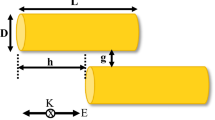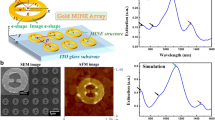Abstract
In this work, a central symmetrical tetramer structure consisting of gold-broken nanorings is proposed, and the plasmonic properties of the system are investigated in the visible range. Four gold broken nanorings are central symmetrically oriented in this structure. Using the finite difference time domain method, the plasmonic scattering efficiency of the system is studied quantitatively, and the electric field distributions at the resonance wavelengths are also investigated. In this work, the structural parameters are respectively varied in the wavelength range from 400 to 1000 nm, including the relative orientation of the broken angles, the thickness of the broken nanorings, the light polarization, and the refractive index of the surrounding environment. It is shown that two different plasmonic resonances are revealed in the gold broken nanorings and that the resonance wavelengths and the peak intensities can also be adjusted by changing the aforementioned parameters. The results demonstrated in this work may be beneficial in the design of plasmonic devices that can operate at visible wavelengths.












Similar content being viewed by others
Availability of Data and Material
All data generated or used during the study appear in the submitted article.
References
Fan JA, Wu C, Bao K, Bao J, Bardhan R, Halas NJ et al (2010) Self-assembled plasmonic nanoparticle clusters. Science 328(5982):1135–1138
Tavana S, Bahadori-Haghighi S (2022) Visible-range double Fano resonance metal-insulator-metal plasmonic waveguide for optical refractive index sensing. Plasmonics 17:2441–2449
Yu S, Su Y, Sun Z, Zhao T, Yu J (2021) Multi-Fano resonances in MIM waveguides coupled with split annular cavity connected with rectangular resonator and application for multichannel refractive index sensor. J Nanophotonics 15(1):016004
Danaie M, Kiani B (2018) Design of a label-free photonic crystal refractive index sensor for biomedical applications. Photonics Nanostruct Fundam Appl 31:89–98
Xu Y, Bai P, Zhou X, Akimov Y, Png CE, Ang LK et al (2019) Optical refractive index sensors with plasmonic and photonic structures: promising and inconvenient truth. Adv Opt Mater 7(9):1801433
Schuller JA, Barnard ES, Cai W, Jun YC, White JS, Brongersma ML (2010) Plasmonics for extreme light concentration and manipulation. Nat Mater 9(3):193–204
Berger CE, Greve J (2000) Differential SPR immunosensing. Sens Actuators B Chem 63(1–2):103–108
Homola J (2008) Surface plasmon resonance sensors for detection of chemical and biological species. Chem Rev 108:462–493
Kotlarek D, Fossati S, Venugopalan P, Quilis NG, Slabý J, Homola J et al (2020) Actuated plasmonic nanohole arrays for sensing and optical spectroscopy applications. Nanoscale 12:9756–9768
Minassian H, Madoyan K, Melikyan A (2012) Strong suppression of surface plasmon radiation damping rate in noble metal nanoshells. Plasmonics 7(4):745–748
Yu P, Chen SQ, Li JX, Cheng H, Li ZC, Liu WW et al (2015) Dynamically tunable plasmonic lens between the near and far fields based on composite nanorings illuminated with radially polarized light. Plasmonics 10:625–631
Therien DA, Hou R, Lagugné-Labarthet F (2020) Second-harmonic generation from dendritic fractal structures. Plasmonics 15:507–515
Wang JX, Zhao J, Chen HB, Qiu WB, Lin ZL, Ren JB et al (2019) The role of the symmetry on the electromagnetic properties of the graphene plasmonic trimer. Optik 181:301–307
Zhu A, Zhang F, Gao R, Zhao X, Chen L, Zhang Y et al (2019) Increasing polarization-dependent SERS effects by optimizing the axial symmetry of plasmonic nanostructures. Appl Surf Sci 494:87–93
Li ZC, Cai HB, Han ZL, Zhang K, Pan N, Wang XP et al (2012) Symmetry-dependent plasmonic properties of three-dimensional hybrid metallic nanostructure arrays. J Phys Chem C 116(33):17781–17786
Kanté B, Park YS, O’Brien K, Shuldman D, Lanzillotti-Kimura ND, Wong ZJ et al (2012) Symmetry breaking and optical negative index of closed nanorings. Nat commun 3(1):1180
Park JH, Ndao A, Cai W, Hsu L, Kodigala A, Lepetit T et al (2020) Symmetry-breaking-induced plasmonic exceptional points and nanoscale sensing. Nat Phys 16(4):462–468
Dana BD, Koya AN, Song X, Lin J (2020) Effect of symmetry breaking on plasmonic coupling in nanoring dimers. Plasmonics 15:1977–1988
Zhang LJ, Jin QJ, Li GX, Zheng JG, Yuan Y, Liu AP et al (2019) Plasmonic waveguide on metal nanowires with various symmetry breaking features. Opt Commun 439:171–175
Jones MR, Kohlstedt KL, O’Brien MN, Wu J, Schatz GC, Mirkin CA (2017) Deterministic symmetry breaking of plasmonic nanostructures enabled by DNA-programmable assembly. Nano lett 17(9):5830–5835
Zhang Y, Xiong T, Dong DD, Wang W, Sun C (2023) Plasmonic characteristics of rhodium dual broken nanorings in UV-visible regime. Appl Phys B 129(4):1–9
Shi DD, Zhang Y, Sun C (2021) Spectral characteristics of asymmetric silver double nanorings surface plasmons. Spectrosc Spect Anal 41(5):1566–1573
Cao W, Pan TT, Deng YL, Li M, Hao H, Xia W et al (2020) Study on the surface plasmon resonance of square and ring/disc array structure. Spectrosc Spect Anal 40(5):1345–1350
Funding
This study was funded by the Education Department Basic Scientific Research Project of Liaoning Province of China (Grant No. LJKQZ2021171).
Author information
Authors and Affiliations
Contributions
All authors contributed to the study conception and design. Software, analysis, and figures were performed by Qinxiu Zhang. Methodology and investigation by Yue Zhang and Tao Xiong. Wei Wang commented on previous versions of the manuscript. The original draft of the manuscript was written by Qinxiu Zhang and Cheng Sun. All authors read and approved the final manuscript.
Corresponding author
Ethics declarations
Ethics Approval
The authors assure that this material is the authors’ own original work, which has not been previously published elsewhere. The paper is not currently being considered for publication elsewhere. The paper reflects the authors’ own research and analysis in a truthful and complete manner. The paper properly credits the meaningful contributions of co-authors and co-researchers. The results are appropriately placed in the context of existing research. All authors have been personally and actively involved in substantial work leading to the paper and will take public responsibility for its content.
Consent to Participate
All authors agreed to participate in this research.
Consent for Publication
Permission from all the authors has been taken to publish this manuscript.
Conflict of Interest
The authors declare no competing interests.
Additional information
Publisher's Note
Springer Nature remains neutral with regard to jurisdictional claims in published maps and institutional affiliations.
Rights and permissions
Springer Nature or its licensor (e.g. a society or other partner) holds exclusive rights to this article under a publishing agreement with the author(s) or other rightsholder(s); author self-archiving of the accepted manuscript version of this article is solely governed by the terms of such publishing agreement and applicable law.
About this article
Cite this article
Zhang, Q., Zhang, Y., Xiong, T. et al. Plasmonic Properties of Gold Central Symmetrical Tetramer in the Visible Regime. Plasmonics 18, 1959–1969 (2023). https://doi.org/10.1007/s11468-023-01911-z
Received:
Accepted:
Published:
Issue Date:
DOI: https://doi.org/10.1007/s11468-023-01911-z




